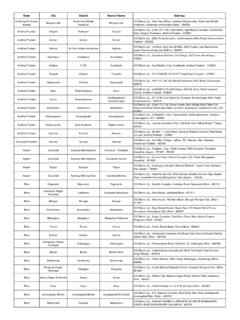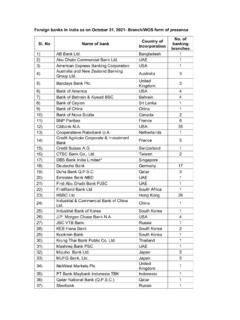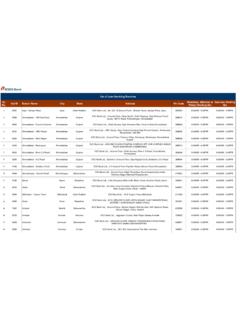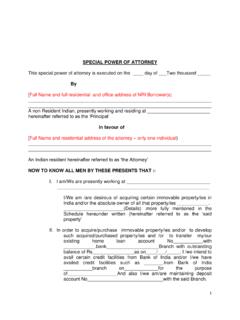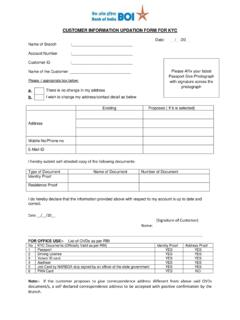Transcription of A Very Big Branch - Azteach.com
1 A Very Big Branch Learning Objectives. Students will be able to: Explain the roles and responsibilities of executive departments and the president s cabinet. Describe how executive departments and agencies enforce governmental policies. Examine regulatory agencies and their social, economic, and political impact on the country. This lesson plan is part of the Executive Branch series by iCivics, Inc. a nonprofit organization dedicated to advancing civic education. For more resources, please visit , where you can access the state standards aligned to this lesson plan. Provide feedback to 2012 iCivics, Inc.
2 You may copy, distribute, or transmit this work for noncommercial purposes if you credit iCivics. All other rights reserved. Time Needed: One class period Materials Needed: Student worksheets Projector / Transparencies Copy Instructions: Reading (2 pages; class set) Worksheet (2 pages; class set) STEP BY STEP Teacher s Guide ANTICIPATE by asking students if they know the different ways the government is involved in their day to day lives. DISTRIBUTE one reading page to each student. READ together with the class, pausing to discuss and explain as appropriate. PROJECT the alphabet soup activity.
3 Use pieces of paper to cover up the acronyms. REVEAL each acronym on it s own. Call on the entire class to guess the acronym. Give clues to the students if they get stuck ( Do you see any patterns? What word does the D usually stand for? Is the D word always included in the acronym? Use each question as an opportunity for discussion and review. DISTRIBUTE one worksheet to each student. REVIEW the answers to the worksheet if you wish. CLOSE by asking students to recall which laws are supreme: United States laws or state laws. A Very Big Branch name : Reading We ve Got a Job to Do The job of the executive Branch is to carry out the laws that the legislative Branch passes.)
4 When you think of the executive Branch , you probably think of the president. But the president is only the head of the executive Branch . He is like the tip of the iceberg: underneath, there is a giant organization with lots of people doing many different jobs. In fact, the executive Branch is the largest Branch of our government! Help From Many Most of the executive Branch is made up of departments and independent agencies. Departments are the main organizations in the executive Branch . There are 15 departments, and each one focuses on a specific type of activity such as education, transportation, defense, or energy.
5 Each department has smaller agencies that do specific jobs. For example, the Department of Justice (DOJ) operates our justice system and works to prevent crime. Two agencies inside the DOJ are the Federal Bureau of Investigation (FBI) and the Drug Enforcement Administration (DEA). The FBI investigates certain kinds of crimes, while the DEA deals with crime related to drugs and controlled substances. Carrying Out Laws: Enforcement What does it mean to carry out a law? That depends on the kind of law that needs to be carried out. Some laws make things illegal and describe consequences for those who do those things.
6 Executive agencies enforce the law when someone isn t following it. There are several things an agency can do to enforce a law: Educate the public about new laws Monitor the public to make sure laws are being followed Catch individuals or organizations not following the law Take the offenders to court Follow any other enforcement procedures the agency may have The Executive Branch President Executive Departments & Agencies The Marshals Service is the oldest federal law enforcement agency. Marshals provide court security, hunt fugitives, and offer witness protection. The president appoints a secretary to lead each department.
7 (But the head of the Department of Justice is called the Attorney General (AG)). These department heads make up the president s cabinet, which acts as a group of advisors to the president. They help the president make important decisions about how laws should be carried out. Independent agencies are government organizations that also focus on specific issues, but they are different from departments because they are independent of the president s control. Instead, these agencies are controlled by a board or commission. The president can appoint someone to the board or commission but cannot remove them. There are 52 agencies and offices within the DOJ.
8 President Obama meets with his cabinet. Carrying Out Laws: Regulations Other laws are just instructions about something that must be done, such as installing new security procedures at the nation s airports. A law like this will not include every last detail about how it should be carried out. Instead, the law will authorize the executive Branch to decide these details. The rules the executive Branch makes about how the law will be carried out are called regulations. Regulations have power similar to laws. Some regulations make activity illegal, and others give instructions for how something must be done. A Very Big Branch name : Reading Maintaining Order and Safety We depend on many parts of the executive Branch to keep us safe and to keep order.
9 For example, the Department of Homeland Security (DHS) is responsible for protecting the United States against all kinds of threats. It includes agencies that deal with terrorism, natural disasters, and border protection. It even includes the Secret Service, whose agents protect the president! Inside the DHS, the Federal Emergency Management Agency (FEMA) responds to natural disasters to help people get the help they need in an orderly way. The Coast Guard, also part of DHS, patrols our nation s coastlines to watch for threats and help boats in distress. Busy, Busy Remember that most of the day-to-day activity in the executive Branch involves ordinary people doing the work that needs to be done: an FBI agent conducts an investigation, a soldier participates in training exercises, or a worker monitors a nuclear reactor at an energy plant.
10 The executive Branch needs people to answer phones, program computers, file papers, do scientific research, process mail, fly airplanes, and clean bathrooms. In fact, the federal government is the nation s largest employer, and most of those jobs are in the executive Branch . Agencies Enforce and Regulate Most departments and agencies both enforce laws and make regulations. For example, the Environmental Protection Agency (EPA) is an independent agency whose goal is to protect the environment and human health. It carries out laws passed by Congress, such as the Clean Air Act that is designed to limit air pollution.
